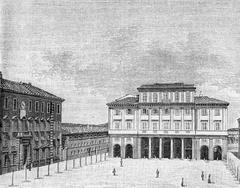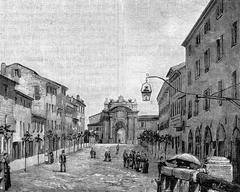
St Peter Cathedral Senigallia: Visiting Hours, Tickets, and Historical Significance
Date: 04/07/2025
Introduction
St Peter Cathedral (Cattedrale di San Pietro Apostolo) in Senigallia, Italy, is a distinguished symbol of religious devotion, architectural evolution, and artistic heritage. Located in the heart of Senigallia on Piazza Garibaldi, this cathedral is not only a place of worship but also a vibrant center of culture and history, reflecting the city’s enduring spirit on the Adriatic coast. This comprehensive guide details the cathedral’s origins, architectural highlights, artworks, visitor information, and its role in the community, ensuring you make the most of your visit to one of the Marche region’s most important landmarks (Feel Senigallia; Christian Directory).
Table of Contents
- Early Foundations and Architectural Evolution
- Construction and Neo-Classical Façade
- Artistic Heritage and Sacred Relics
- 20th-Century Enhancements and Restoration
- Visiting St Peter Cathedral: Hours, Tickets, Tours
- Dress Code, Accessibility, and Visitor Conduct
- Nearby Attractions and Travel Tips
- FAQs
- Summary and Travel Recommendations
- References
Early Foundations and Architectural Evolution
St Peter Cathedral stands on a site with deep historical and spiritual roots. The current cathedral is the fifth church dedicated to St Peter here, with previous versions lost to natural disasters and the changing needs of the city (GoodMarche). The earliest known structure dates back to the Romanesque period, characterized by thick stone walls and rounded arches—a style designed to evoke strength and protection (Christian Directory).
Over the centuries, the cathedral incorporated Gothic, Renaissance, Baroque, and Neoclassical elements. This fusion is evident in both the exterior and interior, symbolizing the city’s resilience and adaptability. The current iteration was built largely between 1762 and 1790 under architect Paolo Posi, exemplifying late Baroque and early Neoclassical styles (Feel Senigallia).
Construction and Neo-Classical Façade
Construction of the present cathedral began in 1762, with completion and consecration on July 4, 1790. The Latin cross plan, three aisles separated by robust pillars, and a central dome give the structure both grandeur and stability—a necessity in this earthquake-prone region (MyCityHunt).
The iconic neoclassical façade, designed by Cavaliere Augusto Innocenti and funded by Pope Pius IX (a native of Senigallia), was added in the late 19th century. Its elegant symmetry and classical proportions enhance the cathedral’s prominence in the urban landscape (GoodMarche).
A striking rose window above the main entrance filters colored light into the nave, symbolizing spiritual enlightenment and marking the architectural transition from Romanesque solidity to Gothic and Renaissance ornamentation (Christian Directory).
Artistic Heritage and Sacred Relics
Inside, the cathedral is a treasure trove of sacred art, with works spanning from the 16th to the 19th centuries. Eleven altars in the sacristy feature paintings by eminent artists, including:
- “St. Paolino and Mary Magdalene” by Domenico Corvi
- “Rest during the Flight to Egypt” by Federico Barocci
- “Assumption of the Virgin” by Alessandro Tiarini
- “Our Lady of Hope” by Ercole Ramazzani
The side walls house 18th-century sculptures of saints, contributing to the solemn ambiance (Anita Villas). The Chapel of the Madonna della Speranza (Madonna of Hope) in the right transept is a focal point for local devotion, especially during the annual feast of Saints Peter and Paul on June 29.
A bronze statue of Pope Pius IX stands in the central nave, commemorating his impactful relationship with the cathedral and the city.
20th-Century Enhancements and Restoration
The cathedral’s interior was enriched with frescoes by Giovanni Marchini in 1931. In 1932, it was designated a minor basilica by Pope Pius XI, underscoring its spiritual and historical importance. Over the years, the cathedral survived several earthquakes (notably in 1836, 1930, and 1997), each time undergoing significant restoration to preserve its structure and artworks (MyCityHunt; GoodMarche).
Visiting St Peter Cathedral: Hours, Tickets, and Tours
Opening Hours
- Monday to Saturday: 9:00 AM – 12:30 PM; 3:30 PM – 6:30 PM
- Sunday and Public Holidays: 9:00 AM – 1:00 PM; 3:30 PM – 7:00 PM
Note: Hours may vary during religious holidays or special events. Check the official website or local tourism office for updates.
Tickets and Entry
- Admission: Free for all visitors
- Donations: Welcomed to support maintenance and restoration
Guided Tours
- Availability: Guided tours are available by arrangement through local tour operators or the Senigallia tourist office.
- Content: Tours highlight the cathedral’s history, architecture, and art.
- Languages: Italian and, occasionally, English or French.
Accessibility
- Physical Access: The main entrance is at street level; the interior is mostly flat.
- Assistance: Staff and volunteers are available to help visitors with mobility needs.
- Accessible Restrooms: Not available inside, but public facilities are nearby.
Dress Code and Conduct
- Wear respectful attire (shoulders and knees covered).
- Maintain silence; phones on silent mode.
- Photography is allowed without flash, except during services. Tripods require permission (thetouristchecklist.com).
Nearby Attractions and Travel Tips
Centrally positioned in Piazza Garibaldi, the cathedral is close to other major sites:
- Rocca Roveresca: A Renaissance fortress with exhibits on local history
- Palazzo Mastai: Birthplace of Pope Pius IX
- Portici Ercolani: Elegant arcades for walking and shopping
- Senigallia’s Beaches: Just a short stroll from the cathedral
- Local amenities: Cafés, restaurants, ATMs, and public restrooms are available nearby
Travel Tip: Senigallia is well connected by train and bus. Parking is available in designated lots outside the restricted traffic zone, especially during summer.
Frequently Asked Questions (FAQ)
Q: What are the opening hours of St Peter Cathedral Senigallia?
A: Monday to Saturday: 9:00 AM – 12:30 PM and 3:30 PM – 6:30 PM; Sunday and holidays: 9:00 AM – 1:00 PM and 3:30 PM – 7:00 PM.
Q: Is there an entrance fee?
A: Entry is free, but donations are appreciated.
Q: Are guided tours available?
A: Yes, guided tours can be arranged through the tourist office or local operators.
Q: Is the cathedral accessible for visitors with disabilities?
A: The entrance is street level, and staff are available to assist. Accessible restrooms are nearby.
Q: Can I take photos inside?
A: Yes, discreet, non-flash photography is permitted except during religious services.
Summary and Travel Recommendations
St Peter Cathedral Senigallia is not just a monument but a living testament to the city’s faith, artistry, and community. From its layered Romanesque foundations to its refined neo-classical façade, the cathedral embodies centuries of architectural and religious evolution (Feel Senigallia; Christian Directory). Its accessibility, free entry, and central location make it an essential stop for any visitor to Senigallia.
Travel Tips:
- Visit early or late in the day for a peaceful experience.
- Combine your cathedral visit with nearby attractions for a full day’s itinerary.
- Take advantage of guided tours or audio guides via the Audiala app for in-depth insights.
- Respect the dress code and the sanctity of the space.
For updates, virtual tours, and event information, consult the official tourism portal or the local tourist information center in Piazza Roma (ermakvagus.com).
References
- Feel Senigallia – Historical Churches of Senigallia
- Christian Directory – Cathedral of St. Peter the Apostle Senigallia
- Ermakvagus – St Peter Cathedral Senigallia
- GoodMarche – St Peter Apostle Cathedral Senigallia
- Italia.it – Senigallia
- Sacred Wanderings – Pilgrimage Sites in Italy
- Anita Villas – Things to Do in Senigallia
- The Tourist Checklist – St Peter Basilica
- Feel Senigallia Main Portal
Experience the spiritual, artistic, and historical richness of St Peter Cathedral Senigallia—where every stone tells a story, and every visit is a journey through time.




